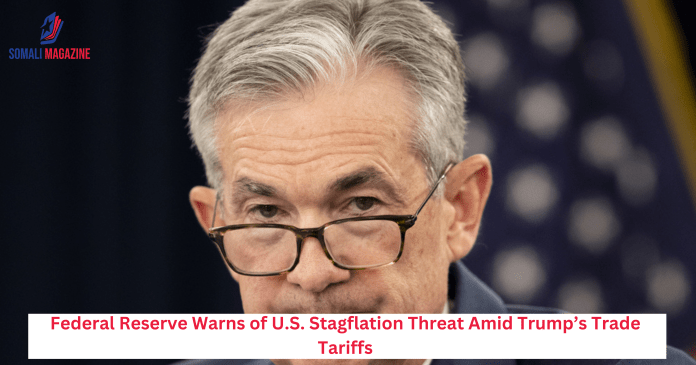Facebook Twitter (X) Instagram Somali Magazine - People's Magazine
Fed Chair Jerome Powell says steep tariffs could slow economic growth, raise inflation, and increase unemployment as uncertainty clouds the U.S. outlook
The United States Federal Reserve has warned that the country could be facing a serious economic problem called stagflation. This happens when prices go up (inflation) at the same time as the economy slows down (stagnation), which makes things very difficult for both workers and businesses.
Jerome Powell, the head of the Federal Reserve, spoke out last night about the danger. He said that the tariffs announced by President Donald Trump in the previous month could harm the economy. These tariffs, which are extra taxes on goods imported from other countries, were supposed to begin right away, but have now been delayed for 90 days. Even with the delay, Powell warned that if the tariffs stay in place, they could slow down economic growth, make things more expensive, and increase unemployment.
Speaking during a press conference, Powell said, “If the large tariff increases are kept in place, they will likely cause higher inflation, lower growth, and more job losses.” He also mentioned that both businesses and families in the U.S. are feeling nervous and uncertain, which means they are holding off on making big decisions—like investments or purchases—because they don’t know what will happen next.
Because of this uncertainty, the Federal Reserve decided not to change interest rates for now. They kept the rate between 4.25% and 4.5%. Interest rates affect how expensive it is to borrow money. Lowering the rate can help boost the economy, while raising it helps keep inflation in check. But when both inflation and a slowdown happen at the same time, it becomes much harder for the Fed to decide what action to take.
President Trump has been very critical of Powell for not lowering interest rates. In fact, he once called Powell a “major loser” and even said on social media that “Powell’s termination cannot come fast enough.” However, after some backlash, Trump later said he had no plans to actually fire him.
Still, the Federal Reserve has to make its decisions based on what’s best for the economy, not on what the President wants. Powell made it clear that the Fed’s actions are not influenced by political pressure. “We don’t let that affect how we do our job,” he said.
The Fed’s main concern right now is that the tariffs may push prices higher while also slowing down economic activity. This combination is what economists call stagflation, and it’s a very hard problem to fix because the usual tools—cutting or raising interest rates—can’t solve both issues at once.
Official government numbers show a mixed picture of the economy. On the positive side, 177,000 new jobs were added last month, which was better than expected. Also, inflation is currently at 2.3%, which is not extremely high. However, on the downside, the U.S. economy shrank by 0.3% in the first quarter of the year. This was partly due to a large number of imports in March, as companies rushed to buy goods before the tariffs kicked in. These imports caused a bigger trade deficit, which hurt overall economic growth.
Powell said if the Fed is forced to deal with both higher prices and rising unemployment at the same time, they will have to make tough decisions. “It would be a complicated and challenging judgment,” he said.
For now, the Fed is watching closely and waiting to see how things develop. Powell stressed that the situation is very uncertain, and businesses and households alike are being cautious.

